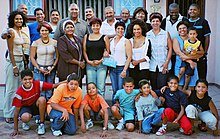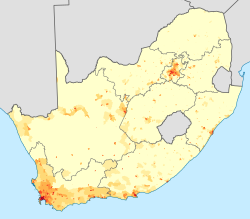Coloured - Simple English Wikipedia, the free encyclopedia
 | |
| Total population | |
|---|---|
| ~ 6,285,300[1] | |
| Regions with significant populations | |
| South Africa (Western Cape and Northern Cape), Namibia, Botswana, Zimbabwe | |
| 4,832,900 (2015; estimated)[2] | |
| 143,799[3] | |
| 17,923[4] | |
| 3,000[5] | |
| Languages | |
| Afrikaans, English | |
| Religion | |
| predominantly Christianity, other religions | |
| Related ethnic groups | |
| Afrikaners, Cape Dutch, Cape Coloureds, Cape Malays, San people, Khoikhoi, Xhosa, Saint Helenians, Rehoboth Basters, Tswana | |

| 0–20% 20–40% 40–60% | 60–80% 80–100% |

| <1 /km² 1–3 /km² 3–10 /km² 10–30 /km² 30–100 /km² | 100–300 /km² 300–1000 /km² 1000–3000 /km² >3000 /km² |

In South African, Namibian, Zambian, Botswanan, and Zimbabwean context, the term Coloured (Kleurlinge in Afrikaans) is used to refer to people of mixed European and Khoisan or Bantu ancestry.
They form the majority of the Northern Cape and Western Cape populations. Most Coloured speak Afrikaans as their first language, although there are some native English speakers. The majority of Coloureds living in Cape Town are able to speak both languages.
Because of South Africa's history of racial discrimination, many feel that the term coloured is derogatory. The official term is "Coloured people", but many Coloureds prefer to call themselves "Black", "Khoisan", or just "South African".
Apartheid
[change | change source]During apartheid, people were classified into four groups: White, Black, Coloured, and Asian. The Cape Malays, who are of Asian descent, were not classified as Asians, but as Coloureds.
Although they were discriminated upon by the government, many Coloureds and Asians got to enjoy certain rights during the apartheid era. For example, they did not have to carry around a passbook, had limited political representation, and were considered citizens of South Africa.
References
[change | change source]- ↑ "The Coloured people group are reported in 17 countries". Retrieved 7 July 2016.
- ↑ "Statistical Release P0302: Mid-year population estimates, 2015" (PDF). Statistics South Africa. 23 July 2015. p. 2. Retrieved 2016-07-08.
- ↑ "Namibia" Archived 2020-04-23 at the Wayback Machine CIA World Factbook. Retrieved 22 July 2016.
- ↑ "Zimbabwe Population Census 2012" (PDF). Zimbabwe National Statistics Agency (ZIMSTAT). October 2013. Archived from the original (PDF) on 1 September 2014. Retrieved 16 February 2015.
- ↑ Milner-Thornton, Juliette Bridgette (15 December 2011). The Long Shadow of the British Empire: The Ongoing Legacies of Race and Class in Zambia (2012 ed.). Palgrave Macmillan. pp. 9–15. ISBN 978-1-349-34284-6.
- ↑ Calafell, Francesc; Daya, Michelle; van der Merwe, Lize; Galal, Ushma; Möller, Marlo; Salie, Muneeb; Chimusa, Emile R.; Galanter, Joshua M.; van Helden, Paul D.; Henn, Brenna M.; Gignoux, Chris R.; Hoal, Eileen (2013). "A Panel of Ancestry Informative Markers for the Complex Five-Way Admixed South African Coloured Population". PLOS ONE. 8 (12): e82224. doi:10.1371/journal.pone.0082224. ISSN 1932-6203. PMC 3869660. PMID 24376522.


 French
French Deutsch
Deutsch